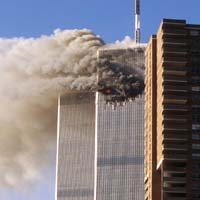Mesothelioma Risk Still Exists After 9/11

A decade after the attack on the World Trade Centers, health officials are bracing for latent health effects such as mesothelioma among the tens of thousands of people exposed to toxic dust at the scene.
The collapse of the World Trade Centers in 2001 released huge clouds of dust and spread high levels of airborne pollutants across Manhattan and part of Brooklyn, New York. Asbestos fibers, which causes mesothelioma, was one of the pollutants released. Malignant mesothelioma is a disease in which a cancer grows on the mesothelium, the membrane that forms the lining of several body cavities.
An estimated 60,000 to 70,000 responders suffered the most concentrated exposure, but thousands of other people who were just in the area at the time – particularly in the first three days after the disaster – are also likely to have inhaled at least some toxic smoke and particulates including asbestos.
Air quality analysis conducted by the Environmental Protection Agency of the World Trade Center site around 9/11 revealed a long list of deadly contaminants. Within the clouds of smoke and dust were asbestos, pulverized concrete, glass fibers, polycyclic aromatic hydrocarbons (PAH’s) and polychlorinated furans and dioxins. An EPA health risk assessment in 2007 concluded that people exposed to these contaminants during the collapse of the towers and for several hours afterward were “likely to be at risk for acute and potentially chronic respiratory effects”. The report confirmed that levels of asbestos, a known cause of mesothelioma, and other toxic substances remained dangerously high for several days after 9/11.
There is also evidence that those materials are still in the lungs of those who inhaled them that day. When a team of New York pathologists examined the lung tissue of seven 9/11 responders who had developed serious lung problems in 2010, they found chrysotile asbestos, along with aluminum and magnesium silicates, small shards of glass and carbon nanotubes. Mesothelioma risk increases the longer asbestos remains in the lungs.
Respiratory problems like bronchitis and asthma had begun to show up among the exposed within weeks after the attack, but a 2006 report from researchers at Mount Sinai Medical Center warned that the long-term consequences of exposure are likely to include late-emerging diseases such as cancer. A more recent study of firefighters who were on the scene on 9/11 appears to bear that out. The firefighters had a higher incidence of all types of cancer. Although the study did not single out mesothelioma as being unusually common, its close association with asbestos and its 10 to 40 year latency period make it likely that the number of cases of mesothelioma among New Yorkers exposed on 9/11 will rise.
Sources:
Wu, M et al, “Case report: Lung disease in World Trade Center responders exposed to dust and smoke”, April 2010, Environmental Health Perspectives, pp. 499-504.
Lorber, M et al, “Assessment of inhalation exposures and potential health risks to the general population that resulted from the collapse of the World Trade Center towers”, October 2007, Risk Analysis, pp. 1203-21.
Moline, J, “Health consequences of the September 11 World Trade Center attacks: a review”, April-May 2006, Cancer Investigation, pp. 294-301.





